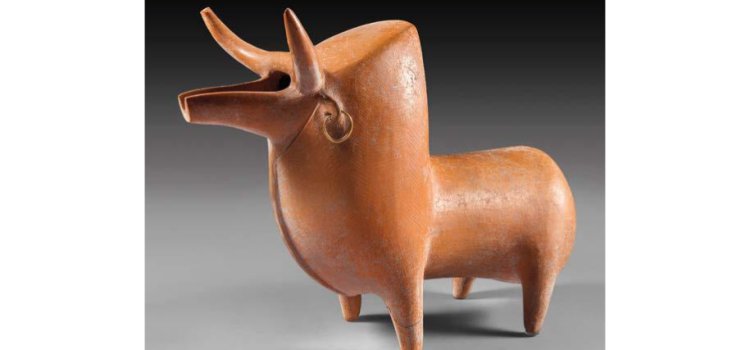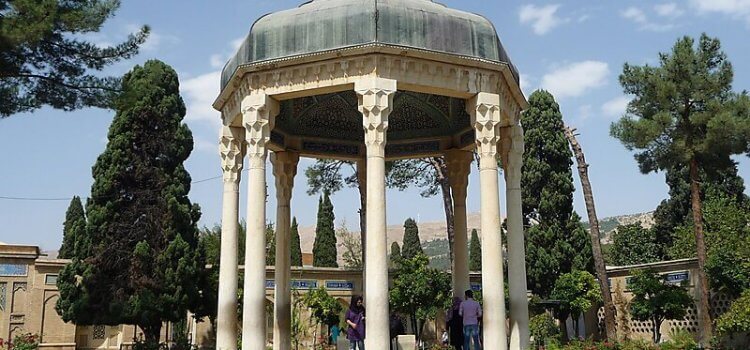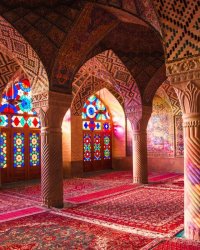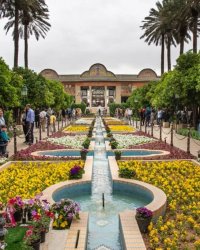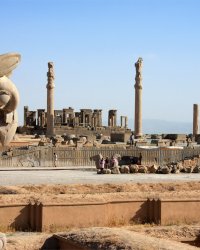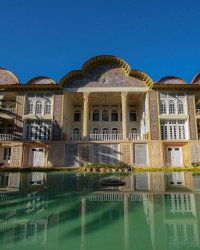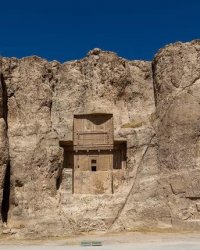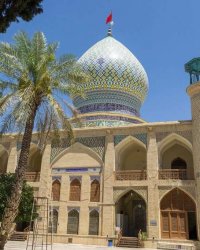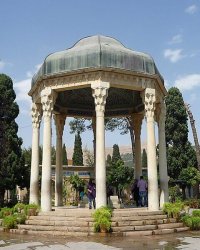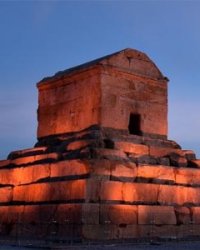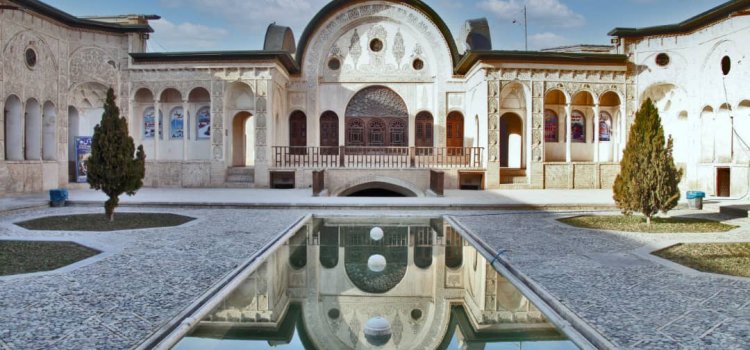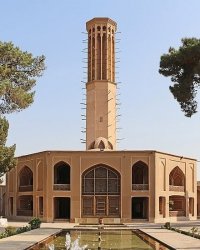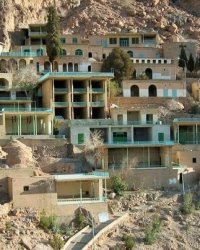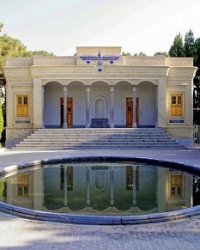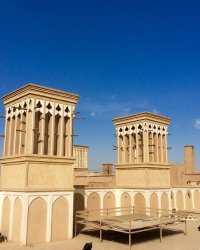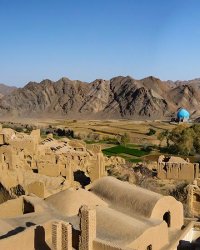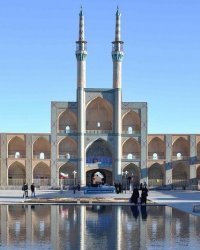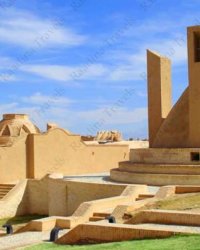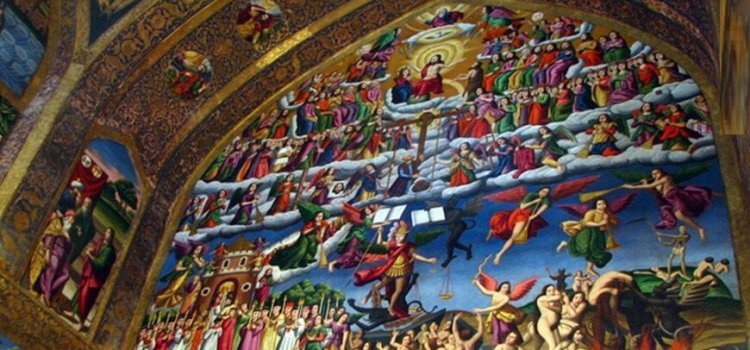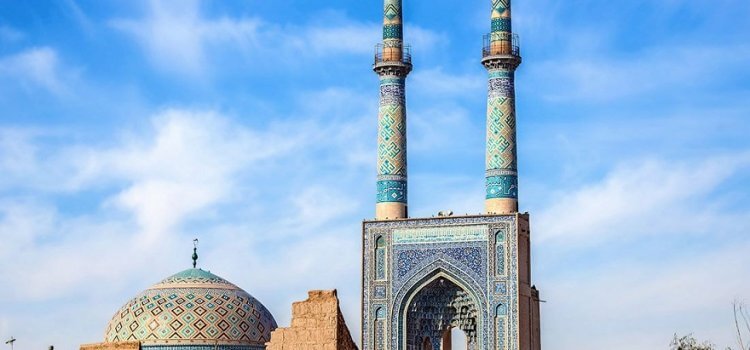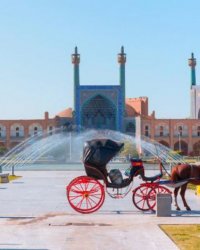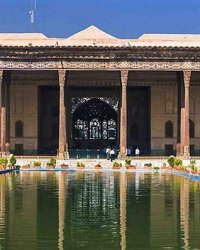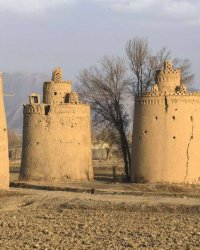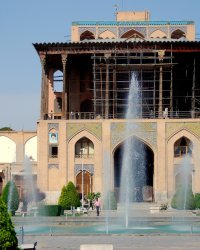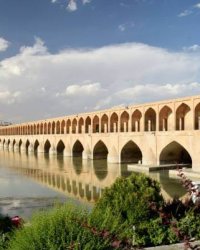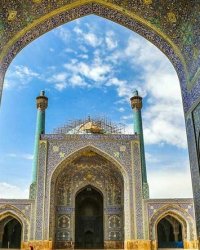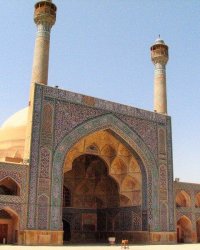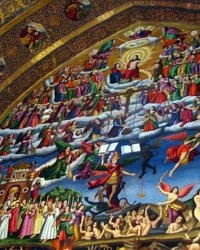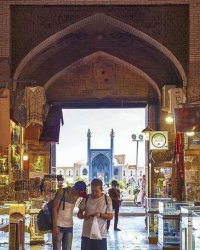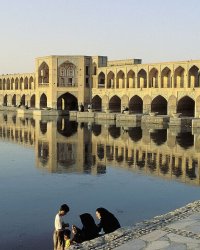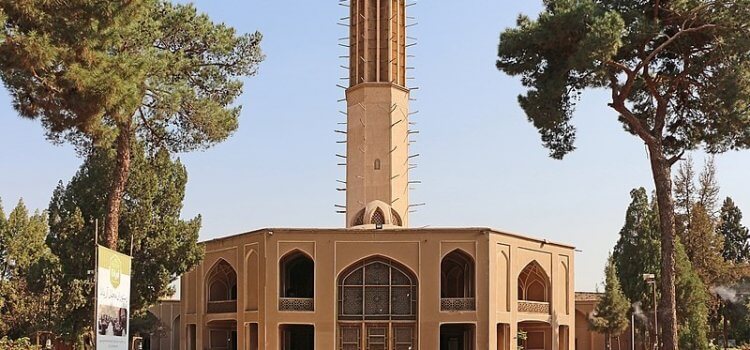National Museum of Iran
Iran-e-Bastan, Archaeological Museum,
The most important archaeological museum in Iran,
built in the 1930s under the supervision of André Godar, the French architect, …
Iran-e-Bastan, National Museum
The most important archaeological museum in Iran, built in the 1930s under the supervision of André Godar, the French architect, to welcome and house the findings from archaeological missions throughout Iran. The entrance was inspired by the magnificent arch of ctisphon palace.
The building has two floors. The first floor reserved for the Paleolithic & prehistoric periods and the ground floor, intended for
the historical periods. Totally the museum covers almost 400000 years time span.
pottery is most abundant item in the museum which also serves as an index in the archeological chronology.
Among the most remarkable showcases we can indicate the one which shows a collection of stamp seals (stamp, signifying the signatures in Antiquity)
and cylindrical seals (mainly used in commerce) and tokens, functioned as delivery note in ancient time
A display case features artifacts from Shahr-e-Soukhteh (the burnt city) that is a site in the southeastern region of Iran in the 3rd millennium B.C. One of the most exciting object is a goblet showing the oldest animated painting in the human history.
A very rich collection of bronze objects from louristan, shows objects of high artistic refinement such as horse bit, pins and funerary artifacts.
A large bas-relief brought from Persepolis showing Xerexes and other courtiers.
A headless statue of Darius from Susa and mosaics from Bishapour (Sassanid period) are other significant objects in the museum.
The location of the museum is in the vicinity of some other museums including Islamic period museum and glassware museum.
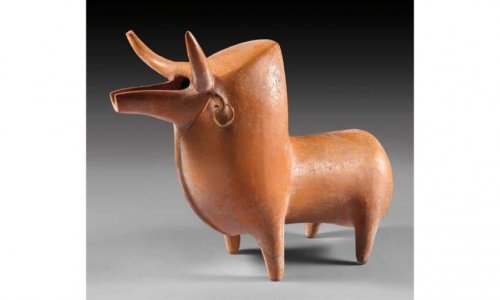
Hafezieh
Hafezieh, the tomb of the great 14th-century Persian poet, the undisputed master of lyrics poetry (Ghazal, a poetic style that deals more with themes of love).
The universal poet, the source of inspiration for great philosophers and writers like Goethe and André Gide.
Hafezieh
Hafezieh, the tomb of the great 14th-century Persian poet, the undisputed master of lyrics poetry (Ghazal, a poetic style that deals more with themes of love). The universal poet, the source of inspiration for great philosophers and writers like Goethe and André Gide.
His poetry deals as much with the worldly subjects (material world) and social theme as with the philosophical and mystical themes beyond our human perception. He talks about wine, beauty, and beautiful faces and appreciates the charm of his hometown Shiraz.
He has only one collection of poetry (Divan) which represents his literary style while there is another poet like Sadi (master of speech) mastering several styles, writes more voluminous works in prose as well as in poetry, but after centuries, it is the poetry of Hafez which has welcomed as interlocutor of advantage among Iranians and admirers of Persian poetry.
Perhaps more than literary and aesthetic reasoning, the enigma of Hafez’s poetry is one reason. Hafez’s poem is surreal and reveals several layers of perception that everyone based on their abilities perceives and translates.
This multifaceted quality has created a tradition called Tafaol (bibliomancy).
By opening Divan of Hafez at random, the verses that come, speak of the wish and foresees the fate of the person.
The ideal man for Hafez (Rend) is a person who does not care about this material and deceptive world that reveals the hypocrisy of the religious and deflects from the populism of authorities which has cost him the disgrace of governors.
The tomb is set in a pretty garden under a dome, it is the most comforting place for young lovers, frustrated by the infidelity of the beloved, seeking a cozy corner to spend some time with Hafez relieving verses.
Shiraz
Visiting Shiraz
Shiraz the city of the wine and the poetry. Its inhabitants are known for their savoir-vivre and their epicureanism.
A soft climate where the winds of the Persian Gulf blow, it is the favorite city of travelers.
The only place on earth where you have to forget the time to earn more and get drunk on the words of its poets in order to appreciate the Persian language.
Achaemenid kings chose the region to build their sumptuous palaces and developed their economy on the fertility of its land.
There are many nomads and cattle in the hinterland of Shiraz, more than anywhere in Iran these days.
Walking in its gardens, the breeze blowning through the slender cypresses, the beautiful voluptuous figure of Hafez’s poems and the rose garden, muse of Saadi, the great sage of moral precepts.
The spring air, perfumed with the scent of citrus trees and jasmine, the young nomade Turk in colorful velvet clothes and silky look.
From shops with vinegar jars and plant juices, to thousands of bottles of beneficial nectar, borage, chicory, Egyptian willow and eglantine.
The Moshir seraglio opens its craft shops and its smiling vendors stock their showcase.
Shiraz Persian beauty, legendary city, eternal capital of epicureans and poets …
Shiraz Attractions and Sights
Tabatabaei house in kashan
Tabatabaei house is one of the numerous old houses in the city of Kashan which was mostly built during 19th century.
This trend of construction reminds the prosperity of Kashan thanks to the carpet production on the field which Tabatabaei family …
Tabatabaei house in kashan
Tabatabaei house is one of the numerous old houses in the city of Kashan which was mostly built during 19th century.
This trend of construction reminds the prosperity of Kashan thanks to the carpet production on the field which Tabatabaei family was reputed for. If we want to enumerate some characteristics of this type of architecture, took into consideration in most of the houses; modest entrance, internal and external courts, reserved for the family and the guests.
Central courtyard surrounded by aestival (normally domed by wind tower) and hivernal (lighted by the sun) habitation for appropriate seasons.
Shah-Neshin, a richly decorated room destined to welcoming the guests .
Interconnected rooms for preserving the family privacy and the master room which dominated the house. Enjoy your visit in Kashan
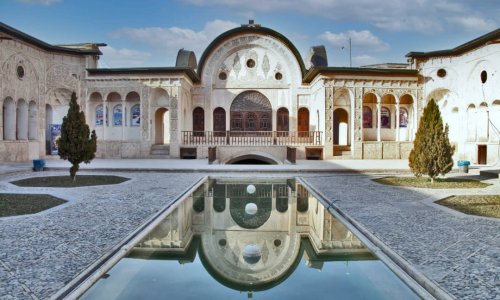
Yazd
Yazd
Yazd, the Pearl of the central desert, is one of Iran’s most charming cities. From its former name Ysatis, it has been a source of inspiration for many artists. Let’s get seduced by its particular architecture and warm people. A discovery to make walking through the heights of its legendary Towers of Silence as well as in the depth of its underground Qanats. Have a fresh cup of water drawn from its cisterns, let our thoughts flow under the coolness of the wind towers that dot the city. Take your backpack to pick up the wonders gleaned from its shopping streets and caravan stops. A visit to the Temple of Fire to pay homage to the souls of Zoroastrian ancestors. A thought for the sacred fire … Let us take a moment to listen to the Muezzin in its oldest mosque …
A taste of the middle east … Come to visit Iran!
Yazd Attractions and Sights
Vank Cathedral in Isfahan
Vank Cathedral,(congregational) the first and the main Armenian church in Isfahan was built in the middle of 17th century
and the differences of its plan to the classic ones has raised some legends and rumors, …
Vank Cathedral in Isfahan
Vank Cathedral,(congregational) the first and the main Armenian church in Isfahan was built in the middle of 17th century after the Armenian immigration forced by shah Abass who wanted to promote prosperity in his new capital, Isfahan.
Brick dome of church and some tiles working seem to be a derivation of Muslim mosques. The paintings are the combination of Byzantine style and Iranian miniature. This church is not in service any more and it is just used as a museum and for administrative matters. An ethnography museum near by shows the history of the Armenians since their arrival.
Jameh Mosque of Yazd
The Jame Mosque or the Congregational Mosque is one of the oldest monuments of the Islamic era in Yazd.
An imposing entrance (the tallest of all mosques in Iran) topped by two minarets that dominate the old city.
Jameh Mosque of Yazd
The Jame Mosque or the Congregational Mosque is one of the oldest monuments of the Islamic era in Yazd. An imposing entrance (the tallest of all mosques in Iran) topped by two minarets that dominate the old city.
Much of the history of The Mosque dates back to Mongolian times in the 14th century. The monument has been restored several times. The last works were carried out between 1954 and 1986. The reputation of the mosque is due to its Persian blue tiles, its mosaics with various floral and geometric patterns, or its fine ornamentation in brick and terracotta.
The water is channeled through a qanat, accessed by a staircase to perform ablution before prayer.
Isfahan
The city of Isfahan, the crossroads of caravan routes, the splendid capital of the Safavids, is an essential stopover on your journey in Persia.
A stop at least three days for an incredible and wonderful discovery of its architectural treasure and monuments.
The Bazaar stretches around the historic center, you need a good sense of direction to find your way around and not get lost in the maze of its passages and seraglios.
The city named three times as the capital of Persia, has preserved much of the vestige of its golden age, the prosperous period of the 17th century, the Safavid era.
From the Jameh Mosque (the benchmark in sacred architecture and ornamentation of Iranian mosques) to Armenian churches (symbols of the history of the Armenian people and the Christian religion), passing by the Synagogue and the Jewish quarter (the oldest inhabitants of the city), its bridges and palaces offer so many choices for entertainments.
You will enjoy it!
Dolatabad Garden
Dolat abad garden is one of the nine Persian gardens registered as the UNESCO world heritage sites which was constructed in 1750.
Its wind tower which is the tallest of its own kind, 34 m high, was built in Qajar era.
Dolat-Abad Garden: A Green Refuge in the Middle of a Thirsty Desert
You may know Iran as a dry land, covered with hot, parched deserts. Well, though Iran actually enjoys different climates, you are not wrong and a large part of it is covered by deserts. However, many of the cities which flourished in these arid lands are spotted by magnificent gardens, inheriting features from a long tradition of garden making which stretches as far back as the Achaemenid Period. As a matter of fact, anyone interested in Iran is well-acquainted with the term “Persian Gardens” and what it connotes.
In this article, we are going to introduce the Dolat-Abad Garden, a heavenly sight which no visitor to Iran should miss visiting. Dowlat Abad Garden was built in the 18th century in the city of Yazd. This enchanting residential-governmental garden, with an area of 6.4 hectares, includes the tallest adobe wind-catcher in the world, large pools of water, many years old pines and cypresses, a very special qanat and delicately designed mansions, unique qualities which designated it as a National Monument in 1965 and a UNESCO World Heritage Site in 2011.
So, whenever you are in Iran, make sure that you will visit the mesmerizing Dolat-Abad Garden and to know more about it, please continue reading out article.
A History of Dolat-Abad Garden
In the first quarter of 18th century and at the end of and Zand dynasty, Muhammad Taqhi Khan Bafqi, known as “Khan-e Bozorg” or “the Great Khan”, entered Yazd with his 70 gunmen and became the ruler of the city for the next 53 years.
As the first contributions to the city, Muhammad Taqi Khan built the 65-km long Dolat-Abad Qanat, originating from Mehriz heights.
Having enough water at hand, he then built the huge Dolat-Abad Garden which was used both as his residence and seat of government. At this time, the garden was located outside the city of Yazd, tightly packed with various kinds of trees. The abundance of trees made the garden also known as “the Garden of Thousand Trees” in the public imagination.
During its life, the garden welcomed many important guests such as Karim Khan Zand. However, little by little, the garden became disused and lost its glory.
Fortunately, in the year 1969, the Ministry of Culture and Art hired the garden from the Department of Religious Affairs and entrusted it to the office for the Protection of Antiquities. Under the protection of its new guardians, the garden was renovated and a new life was injected into its veins.
The Architecture of Dolat-Abad Garden
As we mentioned before, Dolat-Abad Garden was used both as a residential and governmental monument. As a result, the garden is divided into two parts: Biruni (external) and Andaruni (internal). These two parts are located perpendicularly in relation to each other.
- Andaruni (the inner or the residential part of the Dolat-Abad Garden)
The andaruni, or the residential part of the garden, is located on the southern part of the complex. Being the larger part of the garden, it includes the following parts:
- The wind-catcher Pavilion: Attached to the southern wall of the garden, you can find the main mansion of the garden, known as “Emarat-e Badgir” or “Emarat-e Hashti.” In the middle of this two-storey octagonal mansion, there is an octagonal marble pond. On three sides, the pond is surrounded by three large rooms and a corridor. The outer façade of each room is enclosed by a sash window, decorated with colorful stained glass. Each room also includes a pond and a fountain. Attending the garden at the appropriate time, you can enjoy the splendid play of color and light in these rooms.
On the southern side of the pond, there is located the tallest adobe wind-catcher in the world. It is 33.8m. high and 80cm. wide, equipped with a dome-like sky-light. Previously, instead of the dome-shaped skylight, the wind-catcher was equipped with an octagonal skylight.
- Tanbi Hall: On the western side of the wind-catcher mansion, there is a luxurious, square mansion known as the Tanbi hall. This hall also includes a square wind-catcher which faces the garden. The first floor of the Tanbi hall is flanked by several smaller halls, bed-chambers and porches. Under the hall, there is a deep basement. The basement is connected to the garden on one side and to the wind-catcher on the southern side.
- Service-Buildings: On the eastern side of the wind-catcher mansion, there are a number of buildings including a kitchen, a pantry, a coffee house, and also a water cistern. These buildings are generally referred to as service-buildings.
- Watch-Tower: On the western-side of the garden, there is a high adobe wall and a watch-tower built to protect the Andaruni from any foreign intrusions.
- Entrance Gate: The western part of the garden also includes a gate which functioned as the entrance to the inner part of the garden.
- The Garden: The largest part of Andaruni is made up of a splendid garden. Right in front of the Wind-Catcher Mansion, there is a large pool with fountains which stretches up to the southern end of the garden or Biruni. Each side of the pool is divided into four rectangular gardens including the cypress, pine and fruit trees such as pomegranate. The reflection of the wind-catchers and the trees in the pool provide stunning views that you will never ever forget. Be sure to spend enough time in the garden and enjoy the eye-catching scenes in the garden.
- Behesht-Ayin Mansion: On the southern-end of the garden, there is a mansion called Behesht Ayin. Actually, the Behesht-Ayin mansion was used as the winter residence of the Andaruni.
- Biruni: The southern part of the Dowlat Abad Garden, perpendicular to the northern part, makes the external part of the garden, known as Biruni. It includes several structures and mansions such as the entrance, Jelo-Khan Square, Tehrani Mansion and Court House. official ceremonies and sport events were held in this part of the Dowlat Abad Garden. Unfortunately, the external part is not open to visitors
Fire Temple
Yazd Zoroastrian fire temple is a holy monument in which the 1500-year old fire is maintained.
The fire is one the 4 holly elements for the Zoroastrian and also the most important one because not only it’s not been contaminated…
Yazd Zoroastrian Fire Temple
The fire temple of Yazd, also known as Ᾱtash-kadeh Yazd, is one of the holiest places in Iran where followers of the ancient religion of Persia, Zoroastrianism, gather to perform their religious rituals. Although the fire temple itself was built in the 20th century, it holds in its heart one of the most sacred, highly respected types of fire in Zoroastrianism, Ᾱtash Bahram (Raham) or the victorious fire. Zoroastrians, and also historians, believe that the holy Ᾱtash Bahram in the fire temple of Yazd dates back to 470 AD, burning and giving light to the world for around 1500 years.
However, apart from its religious prominence, the Zoroastrian fire temple of Yazd is one of the major tourist attractions in this city. Each year, a large number of eager tourists come to the beautiful Ᾱtash-kadeh of Yazd to visit this sacred place and learn more about Zoroastianism, the first monotheistic religion of the world.
So, if you are going to visit this unique fire temple in the city of Yazd, we strongly suggest that you read the following article to learn whatever you need know before attending this holy place.
A Short History of the Fire Temple of Yazd
During the rule of Achaemenids (550-330 BCE) and Sasanians (224-642CE), Zoroastrianism was the estate religion of Iran. However, after the Arab conquest of Persia in the 7th century AC, Iranians gradually gave up their old religion and converted to Islam. In the 10th century, a large group of Iranian Zoroastrians fled to India and became known as Parsis. Nevertheless, a minority of Zoroastrians remained in Iran, keeping their religion alive in its homeland.
As a minority, Zoroastrians suffered from widespread persecution for long, long years. However, when Reza Shah Pahlavi came to throne, he gave his assent for the construction of an Atash-Kadeh (Fire Temple) in Yazd. Therefore, a group of Iranian Zoroastrians came together to build the fire temple of Yazd city.
As the story goes, Amānat brothers, who were going to keep alive the memory of their father, Ardeshir Mehraban Rostam, dedicated a piece of land as large as 6,881 square meters for the construction of Yazd Fire Temple. Nevertheless, they were short of capital and had to raise funds to build the holy fire temple.
In his memoire, Jamshid Amānat tells the story of his hardships in traveling to India, four times by steam ships and one time by camels and also on foot, to persuade the Indian Parsi Association to pay for the construction of Yazd Fire Temple. At last, Hama Baee agreed to provide the necessary financial resources for the construction of the fire temple.
So, Parsi engineers designed the fire temple and Arbāb Jamshid Amānat supervised its construction and, in this way, Bahram Fire Temple finally came into being in the year 1934.
A Word on the Holy Fire Burning in the Fire Temple of Yazd
Well, let us tell you some interesting facts about the different types of fire lightening the world of Zoroastrianism. Actually, there were three types of fire used in the Zoroastrian world of Persia:
- Court fire burning in houses,
- Aderan (Azaran, Darmehr) fire which was superior to the court fire, lightening larger areas such as cities,
- Fire and Raham (Bahram), or the victorious fire, the most general and prestigious fire types simmering in Zoroastrian fire temples. Currently, you can visit only two samples of this type of in Iran, one in Yazd and the other in Kerman. As Zoroastrians believe, the Bahram Fire itself includes 16 different types of fire and thunderbolt lightening. Each one of these 16 different types has a name which are: Dyer, King or Governor, Potter, Brick, Dervish, Goldsmith, Mint, Armorer, Baker, Distiller, the Army Commander, Shepherd, Religious Leader, Sky Lightning, and, finally, Dead Burner.
As the story goes, the Bahram fire burning in Atashkade Yazd was first kept in one of the greatest Sassanian fire temples, the well-known Pars Kariyan (Azar Farnbagh) fire temple. This fire temple was located in Larestan, a city about 350 km to the South-east of Shiraz. Then, it was taken to Aqda, a city in Yazd province. The victorious fire burnt in Aqda for about 700 years. After that, it was kept alight for 300 years in Ardakan, another city in Yazd province. Finally, the victorious fire landed in the city of Yazd, and with the construction of the Fire Temple of Yazd, it has rested there up to now.
The Architecture and Decorations of the Yazd Fire Temple
The Main Yard: A Symbolic Space of Zoroastrian Beliefs
As you pass through the gates of Yazd Fire Temple, you will enter a large yard, surrounded by ever green cypresses and planes. In the middle of the yard, there is a circular pool filled with water, reflecting back the whole monument.
Behind the pool, there is located the main building of the fire temple of Yazd. Built on a 21-meter-high platform, you should ascend eight steps to enter a small porch which leads into the holly building. Four high-rising columns stand upright in front of the porch, decorating the façade of the main building.
The stone capitals of the columns and the flowers embellishing the walls of the building are delicate works of art by Isfahani stonemasons. These works of art were carved by artists in Isfahan and then were brought to Yazd.
Above the entrance, there is the figure of Faravahar, made by expert Yazdi artists.
The Main Hall
In the porch, there are two wooden doors. Take the one on your right to enter the main hall. As you step into the main hall, you will find a space covered with white marbles, decorated mostly with quotes from Avesta and portraits of the prophet of ancient Persia, Zoroaster.
In the middle of the main hall, you will encounter a glass window through which you will be able to see the holy Atash Bahram (Bahram Fire).
The scared Atash Bahram is kept burning in a bronze container, located on a platform a few meters above the ground level. The bronze container is located itself in a large room, surrounded by other smaller rooms which are used for praying and other religious rutuals.
A person, called “Hirbod”, is responsible for keeping the fire alive. He preserves the fire by adding a piece of dry wood, usually almond and apricot which take longer to be burnt out, several times a day. The remaining ash is of no importance, so it is emptied out of the container whenever necessary.
Visitors can see the fire only through the glass as no human breath should contaminate the pure fire. It is interesting for all tourists that this fire has been burning for this long. They can even smell some of the fire while looking through the glass.
Varjavand Hall
It was in 1939 that Mr. Jamshid Amanat built a hall and a water reservoir in the Yazd Fire Temple complex in memory of his wife. The hall building was destroyed and unusable in 2002 due to old age. Engineer Parviz Varjavand renovated this hall and completed the renovation in 2008, keeping its old style. He did this in memory of his parents, Dr. Fereydoun Varjavand and Dolat Rostami, and the name of Varjavand remained on the hall.
Now, Varjavand Hall has become an exhibition where you can learn more about Zoroastrians, traditions, and religious customs. There are different mannequins, photos and there. In one corner there are a bride and a groom and you read about them, and in another corner, you get information about the Nowruz and the ceremony of the followers of this religion. You can learn about the Zoroastrian prayer, the religious customs, and the ritual of dressing in the same hall.
Water Reservoir of Yazd Fire Temple
Jamshid Amanat was the one who built a water reservoir in the Zoroastrian fire temple. Today, you can visit this reservoir be on the ground floor of Varjavand Hall. On the ground floor, before entering the reservoir, you will encounter an exhibition space where you can see pictures taken by various photographers on subjects related to Zoroastrians. From Nowruz to prayers and religious customs, you can see and learn about them in these photos.
In a corner of the exhibition hall, you have to go down the stairs to enter the water reservoir. The end of the staircase was blocked in the past. And people used a faucet installed at the bottom of the water tank to get the water they needed. Now this faucet and the wall are not there anymore, so tourists can enter the water reservoir room and pay a visit. It’s the water of the qanat that flows through the upper valve of the reservoir so that people can access it.

